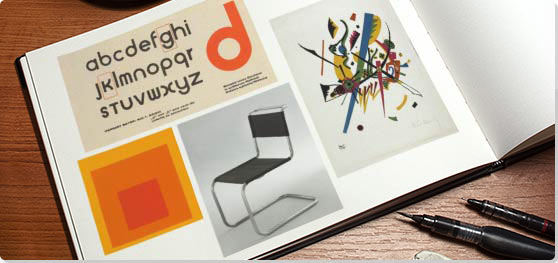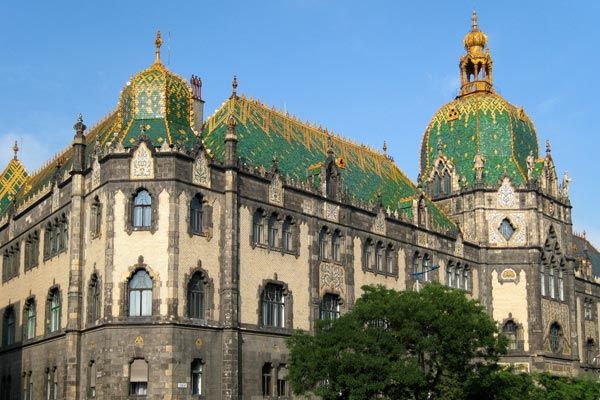Summary of Bauhaus
The Bauhaus was arguably the single most influential modernist art school of the 20th century. Its approach to teaching, and to the relationship between art, society, and technology, had a major impact both in Europe and in the United States long after its closure under Nazi pressure in 1933. The Bauhaus was influenced by 19th and early-20th-century artistic directions such as the Arts and Crafts movement, as well as Art Nouveau and its many international incarnations, including the Jugendstil and Vienna Secession. All of these movements sought to level the distinction between the fine and applied arts, and to reunite creativity and manufacturing; their legacy was reflected in the romantic medievalism of the Bauhaus ethos during its early years, when it fashioned itself as a kind of craftsmen's guild. But by the mid-1920s this vision had given way to a stress on uniting art and industrial design, and it was this which underpinned the Bauhaus's most original and important achievements. The school is also renowned for its extraordinary faculty, who subsequently led the development of modern art - and modern thought - throughout Europe and the United States.
Key Ideas & Accomplishments
- The origins of the Bauhaus lie in the late 19th century, in anxieties about the soullessness of modern manufacturing, and fears about art's loss of social relevance. The Bauhaus aimed to reunite fine art and functional design, creating practical objects with the soul of artworks.
- Although the Bauhaus abandoned many aspects of traditional fine-arts education, it was deeply concerned with intellectual and theoretical approaches to its subject. Various aspects of artistic and design pedagogy were fused, and the hierarchy of the arts which had stood in place during the Renaissance was levelled out: the practical crafts - architecture and interior design, textiles and woodwork - were placed on a par with fine arts such as sculpture and painting.
- Given the equal stress it placed on fine art and functional craft, it is no surprise that many of the Bauhaus's most influential and lasting achievements were in fields other than painting and sculpture. The furniture and utensil designs of Marcel Breuer, Marianne Brandt, and others paved the way for the stylish minimalism of the 1950s-60s, while architects such as Walter Gropius and Ludwig Mies van der Rohe were acknowledged as the forerunners of the similarly slick International Style that is so important in architecture to this day.
- The stress on experiment and problem-solving which characterized the Bauhaus's approach to teaching has proved to be enormously influential on contemporary art education. It has led to the rethinking of the "fine arts" as the "visual arts", and to a reconceptualization of the artistic process as more akin to a research science than to a humanities subject such as literature or history.
Overview of Bauhaus

In his early career Walter Gropius worked for an international conglomerate designing everything from architectural and industrial projects to office lighting and stationery - this led him to envision a total design ethos, employing "a new guild of craftsmen," that he later embodied in founding the Bauhaus.
Artworks and Artists of Bauhaus
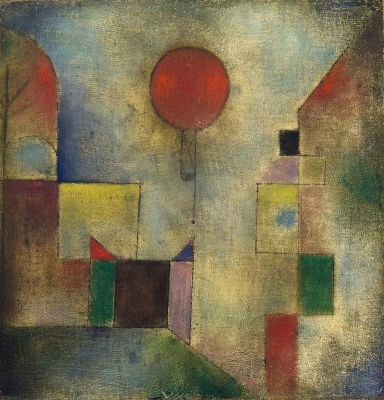
Red Balloon
Paul Klee was one of the most talented and enigmatic artists to be associated with the Bauhaus, a visionary whose work combined stunning formal innovation with a curious kind of primordial innocence. In this canvas from 1922, delicate, translucent geometric shapes - squares, rectangles and domes - are picked out in gradations of primary color. A single red circle floats in the upper center, revealing itself, on inspection, to be the titular hot-air balloon. This illustrative flourish exemplifies Klee's whimsical, associative use of the geometric compositional arrangements for which the Bauhaus became famous. In the artist's unique idiom, emphasis shifts restlessly between the abstract and the figurative, between narrative association and esoteric symbolism. The glowing shapes, reminiscent of stained glass, are placed asymmetrically to create a visual rhythm, conducted by vertical, horizontal, and diagonal lines, that seems both ordered and spontaneous.
Born in Switzerland in 1879, Klee had been associated with various Expressionist and modernist groupings in Northern Europe during the 1900s and 1910s, including Der Blaue Reiter group, before taking up a post at the Bauhaus in 1921, teaching mural painting, stained glass, bookbinding, and various other subjects. He published his art lectures in his Pädagogisches Skizzenbuch (Pedagogical Sketchbooks) (1925) in the Bauhausbücher series. Famously beginning with the line "[a]n active line on a walk, moving freely, without goal," this work became hugely influential, establishing, as the critic Mark Hudson puts it, "[Klee's] reputation as one of the great theorists of modern art...[as] he attempted to analyze every last permutation of his wandering lines." For Klee, the line, developing from a single point, was an autonomous agent, spontaneous, which through its movement forged the development of the plane. This metaphor for the germination of compositional form became a fundamental tenet of Bauhaus design philosophy, influencing many of Klee's contemporaries, including Anni Albers and Klee's lifelong friend Wassily Kandinsky.
Klee's presence at the Bauhaus from 1921 until his resignation in 1931 gives the lie to stereotypes of the institution as overly preoccupied with rationality and dry, formal methods. Klee's work - both sophisticated and primitive, figurative and otherworldly - had a noted impact on later artists in America and Europe, including Jackson Pollock, Adolph Gottlieb, Robert Motherwell, Kenneth Nolan, Norman Lewis, and William Baziotes. As Clement Greenburg wrote in 1957, "[a]lmost everybody, whether aware or not, was learning from Klee."
Oil on chalk-primed gauze, mounted on board, - The Solomon R. Guggenheim Museum, New York, New York
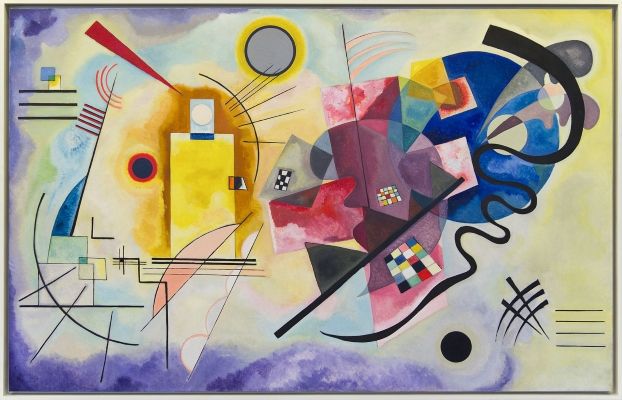
Yellow-Red-Blue
This complex work is built up around three key visual areas, dominated by yellow, red, and blue shapes respectively. These in turn form two overall zones of visual attention, one on the right-hand side of the canvas, formed from the interlocking red cross and blue circle, and one around the yellow rectangle to the left, embossed against a deeper shade of ochre. Variance in visual weight and positioning in space is implied by effects of color and shading, as the buoyancy of the yellow contrasts with the darker red tones, deepening further into purple and blue. A meshwork of straight and curvilinear interact across the canvas, as if playing out the battle of energies established between the different primary colors.
Wassily Kandinsky was born in Moscow in 1866, and had settled in Germany before the close of the 19th century, becoming a key figure in the development of Northern-European Expressionism over the following years; his 1903 painting Der Blaue Reiter was the inspiration for the Expressionist art group of that name. Following a six-year spell in Soviet Russia bookending the revolution (1914-20), Kandinsky returned to Germany and began teaching at the Bauhaus in 1922, by which time his work had moved towards a purer form of abstraction. As a tutor on the preliminary course, he introduced his students to the analysis of primary colors and the nature of their interaction. In 1923, hoping to establish an underlying qualitative relationship between particular shapes and colors, he developed a questionnaire in which participants were asked to fill in a triangle, square, and circle the most appropriate primary color. The resulting yellow triangle, red square, and blue circle became a classic Bauhaus motif, one which Kandinsky explored and subverted in this famous work, transforming it into a lyrical evocation of the relationship between visual and musical expression. The same ideas informed his famous text Point and Line to Plane (1926) influenced by new research on Gestalt psychology, a key discussion-topic at the Bauhaus at this time. Kandinsky was interested in how certain combinations of color, line and tone might have innate spiritual and psychological effects, which were in turn connected to certain musical motifs.
As the art historian Annagret Hoberg notes, however, the connotations of this painting extend beyond this, taking in more figurative realms: "[the] two centers...conjure anthropological associations. While in the yellow field one might see a human profile due to the structure of the lines and circles, the intertwining of red and blue form with the black diagonal is reminiscent of the theme of the battle between Saint George and the dragon" It is perhaps these more human associations which explain the iconic status of Kandinsky's abstract paintings in modern art history: as Hoberg notes, Yellow-Red-Blue "exerted an influence on later modernism, including, for example, Barnett Newman's series Who's Afraid of Yellow, Red and Blue (1966-69)."
Oil on canvas - Musée National d'Art Moderne, Centre Pompidou, Paris, France
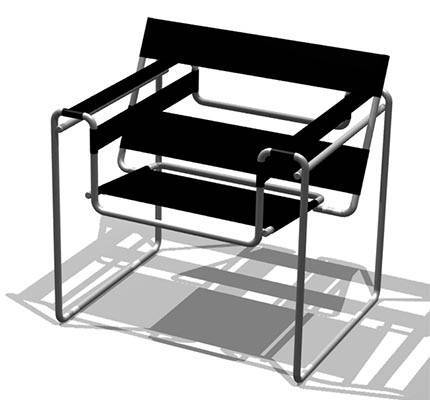
Club Chair (Model B3) (The Wassily Chair)
Marcel Breuer's classic Model B3 chair is a revolutionary take on the classic upholstered 'club chair' of the nineteenth century drawing room, a sleek amalgamation of curving, overlapping stainless steel tubes, with taut rectangular fabric panels floating like geometric forms in space. The artist himself described the chair as "my most extreme work . . . the least artistic, the most logical, the least 'cozy' and the most mechanical." But it was also his most influential, exemplifying the groundbreaking developments in functional design that were marking out the Bauhaus by the mid-1920s. Lightweight, easily moved, and easily mass-produced, it met all the requirements of the school's design philosophy, its components arranged with a clarity that made its structure and purpose immediately legible.
Born in Hungary in 1902, Breuer was amongst the youngest members of the original Bauhaus generation. Leaving his home-town of Pécs at the age of eighteen, he enrolled at Gropius's revolutionary new school in 1920, becoming one of its first students. Singled out as a prodigy, he was placed in charge of the woodwork shop, and after a sojourn in Paris returned to the Bauhaus as a teacher in 1925. A committed cyclist, Breuer saw the bicycle as the paragon of modern design, and was fascinated by his bicycle's curved handlebars, made of a new kind of tubular steel developed by the Mannesmann manufacturing company. He realized that the same material, which could be bent without breaking, might be used in furniture design: the 'club chair' is in part the result of this moment of inspiration. In order to produce his furniture on a large scale, Breuer started the company Standard Möbel in 1927. The colloquial name for the chair honors the painter Wassily Kandinsky, who admired the piece when he first saw it in Breuer's studio.
As the art historian Seamus Payne notes, Breur's was "the first ever chair to feature a bent-steel frame...it marked the beginning of a new era in modern furniture with a design that maintains a progressive look even today." After World War II the Italian firm Gavina began producing the chair, ensuring its longstanding influence on design history, and marketing it as the "Wassily Chair." In 1968 the American company Knoll bought out Gavina and began manufacturing the Model B3, which, as a result, can still be purchased today.
Chrome-plated steel, canvas upholstery - The Metropolitan Museum of Art, New York
Universal Bayer
Herbert Bayer's Universal Bayer typeface, a classic of International Style typography, employs a minimal geometric design of the sans-serif type favored by the Bauhaus. At the same time, the simplicity of the design reflects Bayer's interest in enhanced legibility, generating a large amount of negative space between characters, in contrast to the cramped calligraphic scripts of traditional German typography. Describing typography as "human speech translated into what can be read," Bayer wanted written language to have the clarity of speech, and used only lower-case letters for this design since there was no phonetic distinction between upper and lower case. Each character has the same width, meaning that the letters represent interchangeable spaces on the page. The type was therefore extremely easy to work with and could be adapted to typewriter keyboards and typesetting machines. These aspects of the design perfectly sum up the Bauhaus emphasis on functionality and mass producibility.
Like Breuer, Bayer was one of the younger members of the Bauhaus's golden generation, born in Austria in 1900. He initially trained as an architect, and in the late 1910s was part of the Darmstadt Artist's Colony, falling under the influence of that group's Jugendstil or Art Nouveau principles, as well as its emphasis on the idea of the 'total work of art'. However, in 1920 Bayer became intrigued by Gropius's new endeavor, and in 1921 enrolled at the school, studying under Kandinsky, Klee, and Moholy-Nagy. Returning as a teacher in 1925, he was named the Bauhaus's director of advertising and printing during the Dessau phase. He developed the Universal Bayer typeface after Gropius commissioned him to create a typeface which could be used in all Bauhaus publications. At this time, German printers still generally favored Fraktur, a dramatic Gothic typeface designed in the 16th century for Albrecht Dürer's Triumphal Arch (1526) woodcut. By stripping out the ornamentation of German script, Bayer expressed the spirit of a new cultural movement that rejected backwards-looking nationalism and embraced cosmopolitan modernity, a movement spearheaded by the Bauhaus, and later snuffed out by the Nazis. His design was also intended to work within a classic Bauhaus compositional concept, wherein letters were arranged in diagonals lines thrusting upwards across the page, wrapping around objects and picked out in strong colors.
Bayer's typeface was never cast in metal, but its influence has been widespread and longstanding. As well as standing at the forefront of developments in International Style typography across the 1920s-50s, influencing the Architype Bayer and Architype Schwitters typefaces amongst others, it is also the inspiration for Google's Product Sans, and for Bayer Next, a typeface designed by Sascha Lobe for the Bauhaus-Archiv Museum in Berlin in 2014.
Typeface
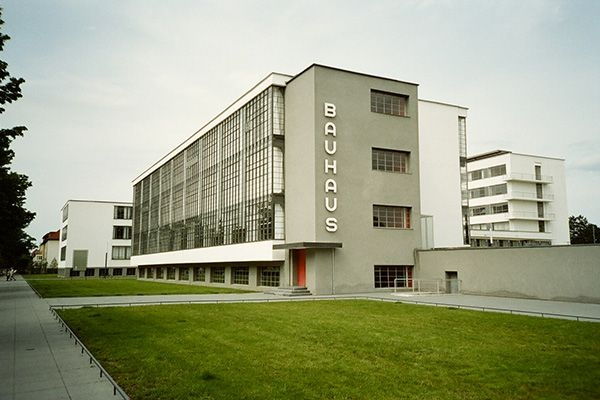
Bauhaus building in Dessau, Germany
This iconic building, with its spare rectangular shape, glass-curtain walls, and distinctive vertical logo extending up one side, encapsulates the spirit of Bauhaus architecture, and predicts many of the developments that would emerge out of it in the years to come. As the architectural critic Lee F. Mindel wrote, Gropius's "innovative use...of industrial sash, glass curtain walls, and an asymmetrical pinwheel design forged an unforgettable path in the development of what we now call modernism and the International Style."
Born into a culturally and politically well-connected family in Berlin in 1883, Walter Gropius was a decorated war-veteran and avowed patriot, whose advocacy of modernist design principles would see him hounded from his home-country by the Nazis. Like fellow giants of modern architecture such as Ludwig Mies van der Rohe and Le Corbusier, he worked in his youth for the influential proto-modernist architect Peter Behrens, and in 1913 published an article on "The Development of Industrial Building", featuring pictures of utilitarian structures such as grain-elevators, which would become a classic statement of the 'form-follows-function' philosophy of modernist design and building. In forming the Bauhaus in 1919 from two existing schools - the Grand-Ducal Saxon School of Arts and Crafts and Weimar Academy of Fine Art - he redefined the Arts and Crafts aesthetic for the twentieth century. However, the famous headquarters above was created for the school's relocation to Dessau in 1925. The project was funded by the city council, which also provided the land for the site. At that time, the Bauhaus was seen as a vital part of the culture of Dessau, which was then in the process of reinventing itself as a modern industrial center.
Amongst the innovative features of the building are the new relationship it establishes between the viewer and the overall architectural space: the three wings, separated according to their functions, are adjoined asymmetrically, with no central view, so that the building can only be experienced by circumambulating it. The use of glass walls on recessed beams, meanwhile, not only creates light-filled interior but also allows for an outside view into the interior functions of the building, suggesting a spirit of openness and transparency. The succession of changing perspectives which the building affords reflected Gropius's vision for social evolution: for the emergence of a more egalitarian, rational, orderly culture. With the design of this building, Gropius laid down a blueprint for the minimalist functionalism which dominated twentieth-century architecture, predicting in particular the development of the so-called International Style - a kind of globalized variant of Soviet and Northern-European Constructivist architecture - during the 1930s.
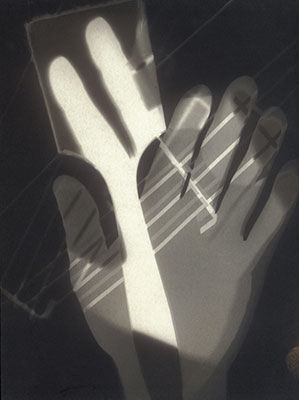
Photogram
In this cameraless photograph or "photogram", the artist's hand seems to materialize out of the darkness and float in space, behind a grid of burning white lines which intersect with his finger-tips. As if taking shape from the interplay of shadow and light, the forms seem not only to materialize on the page but also somehow like the dematerialized echoes of physical objects: they become, as the art historian Leah Dickerman puts it, "trace[s] of physical contact." Moholy-Nagy was amongst various European artists, including Christian Schad and Man Ray, who experimented with the photogram - a term coined by Moholy-Nagy - under various names during the 1910s-20s, but through the endeavors of Moholy-Nagy, these works of Abstract Photography became indelibly linked with the Bauhaus's revolutionary ethos.
László Moholy-Nagy was born in Hungary in 1895. In 1920 he emigrated to Germany, and in 1923, with his artistic reputation already somewhat in place, he was invited by Gropius to take over the running of the school's "basic course" or vorkurs from Johannes Itten. Though Moholy-Nagy worked across a range of media, his photograms became icons of Bauhaus experimentation. Created by placing objects on photo-sensitive paper exposed to ambient light, these works, in the artist's own words, made light "the medium of plastic expression". Though photography was not officially part of the school's curriculum, Moholy-Nagy operated as a photographic department of one, and his ardent enthusiasm inspired many of the Bauhaus's faculty and students to undertake their own photographic experiments. Fascinated by light, Moholgy-Nagy would continue to explore the possibilities of the photogram throughout his career, notably at the Chicago School of Design, which he founded in 1939 after moving to America. "Light laboratory" courses were fundamental to the curriculum at Chicago, and Moholy-Nagy's work influenced many subsequent North-American artists, such as Arthur Siegel.
Moholy-Nagy's photograms stand as monuments to the pioneering technological and creative spirit of the Bauhaus: in particular its commitment to exploring the elementary properties and aptitudes of different artistic media. In essence, they represent explorations of the principles of photosensitivity in their purest, most unsullied form, and thus sum up the 'form-follows-function' ethos now associated with the school, and with the broader movement of Constructivism.
Gelatin silver print - The Metropolitan Museum of Art, New York
Wall Hanging
This striking wall-hanging employs lines, rectangles, and squares arranged in gradations of white, grey, black, and brown, creating a dynamic sense of spatial movement, as the forms seem to recede and leap out of the textile substrate. Vertical and horizontal planes come alive in the asymmetrical grid, as tonal associations between different sections of the chequerboard surface create an endlessly unfolding rhythm of momentary geometric configurations. Anni Albers was interested in reinvesting traditional crafts such as weaving with a sense of modern innovation by altering their basic functional principles. As she put it, "where the functional aspect of the basic structure is moderated, aesthetic qualities frequently move to the foreground - in fact, they often are the very reason for the structural change."
Anni Albers was born Annelise Else Frieda Fleischmann in Berlin in 1899 (in 1925 she married the Bauhaus and Black Mountain College teacher Josef Albers). The daughter of a furnituremaker, Albers briefly studied at a school of applied art in Hamburg in 1919, but soon left, and three years later enrolled at the Bauhaus. Weaving was one of the few workshops open to Albers as a woman, and she initially took it up reluctantly, though she would ultimately become a pioneer of the medium. She credited Paul Klee's 1927 weaving course as a key influence, especially "his repeated insistence that the ultimate form of the work was not as important as the process leading to it." She later recalled: "I heard [Klee] speak and he said take a line for a walk, and I thought, 'I will take thread everywhere I can.'" Taking an innovative and intuitive approach to her work, she interpreted the Bauhaus emphasis on form following function as a pretext to experiment with the basic tenets of the weaving process: this piece, for example, is one of the first examples of textile-work incorporating artificial silk. Combining synthetic and organic materials, patterns and spontaneous decision-making, hand-weaving and loom-weaving, "she provided," as art historian Virginia Gardner Troy puts it, "an alternative to the narrative and figural European tapestry tradition - in which a textile was produced by weavers based on cartoons often created by others - and allowed the modern weaver to compose directly on the loom."
In the introduction to her noted book, On Weaving (1965), Albers wrote that she hoped to "include in my audience not only weavers but also those whose work in other fields encompasses textile problems." Her hope has been borne out, and her work has become seminal not only to those working in textiles, but also within architectural and design fields. Theorist and designer R. Buckminster Fuller stated that "Anni Albers, more than any other weaver, has succeeded in exciting mass realization of the complex structure of fabrics." In 1949, Albers became the first textile artist to exhibit at the Museum of Modern Art, and her work continues to receive contemporary critical interest, with major exhibitions at the Guggenheim Bilbao in 2017 and at the Tate Modern in 2018.
Two-ply weave silk - The Busch-Reisinger Museum, Harvard University
Model No. MT 49
This elegant and innovative teapot uses the interplay of geometric forms as the basis for a distinctively modern design, with its hemispheric body centered on crossbars and topped by a flat circular lid. The handle, a half-circle of ebony, and the cylindrical knop, are also made of ebony, and contrast vertically with the horizontal plane of the body, a juxtaposition complemented by the contrast in materials and colors. As the art curator Christian Witt-Dörring puts it, "[e]ach individual part - lid, handle, spout and base - can be clearly read. Brandt then put all of them together again by creating an abstract sculpture, which, at the same time, is a teapot. The flat and spherical shapes harmonize perfectly."
One of only a few women on the Bauhaus faculty during the 1920s, Marianne Brandt was responsible for creating many of the functional objects that we now recognize as quintessential works of modernist design. Born in Chemnitz, Germany in 1893 as Marianne Liebe, she enrolled at the Bauhaus in 1923, and began studying under Moholy-Nagy in the metal workshop in 1924, becoming the first woman admitted into his studio. Brandt made the prototype for her teapot the same year, subsequently producing six other prototypes, though the design was never marketed commercially. Standing at only three inches tall - a little larger than a teacup - the teapot was intended to create a concentrated tea extract. which could then be diluted with hot water to whatever strength was desired.
In 1928, Brandt would succeed Moholy-Nagy as director of the metal workshop, a testament to the esteem in which she was held by her peers. In the decades since her death, Brandt's designs have become icons of Bauhaus and Constructivist aesthetics. The curator of the Berlin Bauhaus Archive Klaus Weber has called Brandt's Model No. MT 49 "Bauhaus in a Nutshell", a work which exemplifies the school's industrial design aesthetic and emphasis upon functionality. One of Brandt's prototypes for the teapot set a record price for Bauhaus objects at Sotheby's in 2007.
Silver-plated brass and ebony - The Metropolitan Museum of Art, New York
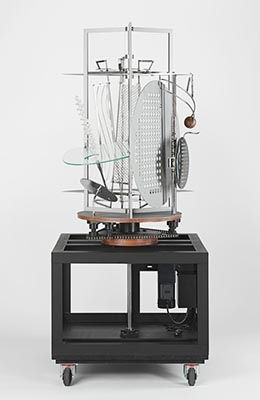
Light Prop for an Electric Stage (Light Space Modulator)
To design and realize this motorized sculpture - described by the art critic Peter Schjeldahl as a "twentieth-century utopian icon" - Moholy-Nagy collaborated with the engineer Istvan Sebok, the technician Otto Ball, and the theatrical lighting department of the German electric company AEG. The innovative use of modern materials to create the work, which was initially intended for commercial use in theatres, epitomizes the Bauhaus emphasis on mass production, the machine aesthetic, and the use of modern technology to make works of functional art. The artist himself said that his Light Prop was designed for "creating special lighting and motion effects". It also expressed Moholy-Nagy's interest in light itself as a creative agent, capable of forging new perceptions of space. He used the machine both for his own works of abstract theatre and in his short experimental film Lightplay: Black, White, Gray (1930), in which the Light Prop is the central 'actor,' casting reflections and shadows on a myriad of surrounding surfaces.
Moholy-Nagy onace stated that "to be a user of machines is to be of the spirit of this century." After he became the director of the Bauhaus's preliminary course in 1923, these ideas played a leading role in the school's development along the rationalist, Constructivist lines for which it is now remembered. He felt that the Bauhaus's early emphasis on Gesamtkunstwerk or the total work of art - influenced by the Expressionist philosophy of Itten - should be redirected toward an ideal of Gesamtwerk, a total work, which he identified with life's biological unity. Artistic experience was not to be partitioned off from life, but was to take its place as an integrated aspect of a broader, embodied perceptual process. Light Prop for an Electric Stage exemplifies this philosophy: Moholy-Nagy felt that its use of motion and time-bound light-patterns - dependent upon the viewer to create their own unique, narrative experience of the work - would transform his audience from passive recipients into active participants within an immersive creative environment.
The idea of an immersive artistic environment was highly attractive to the second-wave avant-garde movements of the 1960s, and sure enough, Moholy-Nagy's Light Prop received great interest during that decade. It was seen as a forerunner of the Kinetic Art movement which was by that point in full swing, and was included in several exhibitions of kinetic sculpture, as well as being exhibited at the Museum of Modern Art in New York in 1968. Two working replicas of the Light Prop were made in 1970, and the Tate constructed a third in 2006. The work therefore indicates the influence which Bauhaus themes and forms would have on the modern spirit of later avant-garde art movements.
Aluminum, steel, nickel-plated brass, other metals, plastic, wood, and electric motor - The Busch-Reisinger Museum, Harvard University
Homage to the Square: Dissolving/Vanishing
This canvas, one of hundreds created as part of Albers's vast Homage to the Square project, contains several squares, declining in size and oriented toward the lower edge of the pictorial frame. The red of the central square is, perhaps, only apparently red, as the viewer's perception of it is influenced by the hues of the outer squares: an example of what the artist called "the interaction of color". As Albers put it in his influential 1963 book of that name, "[i]f one says 'Red' (the name of a color) and there are 50 people listening, it can be expected that there will be 50 reds in their minds. And one can be sure that all these reds will be very different." Due to the interaction of the color and the placement of squares within squares, the image can also paradoxically appear to both advance and recede, subverting the two-dimensional pictorial plane.
Josef Albers, born in Westphalia, Germany in 1888, initially enrolled to study at the Bauhaus in 1920, having previously worked as an art teacher. In 1923, Gropius asked him to take over teaching of the intermediary werklehre course focused on functional techniques, and Albers continued to work at the school until its closure, following it from Weimar to Dessau to Berlin. In 1933 he emigrated to America, where he became the director of Black Mountain College in North Carolina. He described Homage to the Square, which was made up of over a thousand paintings, as a set of "platters to serve color." He began the series in 1949, when he already was sixty-two years old, and continued to work on it until his death in 1976, by which point it had become the culminating achievement of his career.
Through his work at Black Mountain and subsequently at Yale, Albers was hugely responsible for the transferal of its creative principles to North America in the decades following the school's closure. Through his work at those two institutions, and through monumental late works such as Homage to the Square, Albers influenced a whole swath of late-twentieth-century art-movements, including Op Art, Conceptual Art, Color-Field Painting, Hard-edged Geometric Abstraction, and Minimalism, as well as artists such as Bridget Riley, Richard Anuszkiewicz, Frank Stella, and Robert Rauschenberg.
Oil on Masonite - Los Angeles County Museum of Art
Beginnings of Bauhaus

The Bauhaus, named after a German word meaning "house of building", was founded in 1919 in Weimar, Germany by the architect Walter Gropius. In 1915 he had taken over the Grand-Ducal Saxon School of Arts and Crafts, and it was through the merger of this institution four years later with the Weimar Academy of Fine Art that the radical new design school was formed. In conceptual terms, the Bauhaus emerged out of late-19th-century desires to reunite fine and applied art, to push back against the mechanization of creativity, and to reform education. At the same time, the development of Russian Constructivism in the 1910s provided a more immediate and stylistically apposite precedent for the Bauhaus's merging of artistic and technical design. When the Bauhaus opened its doors in 1920, however, it was a sign of its debt to the aesthetic fashions of the previous decades it took up residence in the former sculpture studio of the Grand-Ducal Saxon School, designed in the Art Nouveau style by the school's penultimate director Henry van de Velde.
Gropius called for the school to show a new respect for craft and practical technique, suggesting a return to the attitudes towards art and craft that had characterized the medieval age. He envisioned the Bauhaus as encompassing the full totality of artistic media, including fine art, industrial design, graphic design, typography, interior design, and architecture.
Bauhaus: Concepts, Styles, and Trends
The Bauhaus Teaching Curriculum
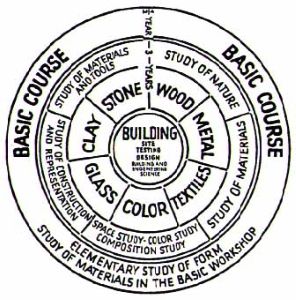
Central to the school's approach was its original and influential curriculum. This was characterized by Gropius as a wheel made up of concentric rings, with the outer ring representing the vorkurs, a six-month preliminary or 'basic course', initiated by Johannes Itten, which concentrated on the fundamental aspects of design, in particular the contrasting properties of various forms, colors and materials. The two middle rings represented two intermediary three-year courses, the formlehre, which focused on problems related to form, and the werklehre, a programme of practical, workshop-based instruction oriented around technical crafts and skills. These classes emphasized functionalism, in particular the use of simple geometric forms that could be reproduced with ease, a conceptual lynchpin of modernist architecture and design across the decades to come. At the center of the wheel were courses specializing in building construction, teaching students the essentials of architectural design, engineering and construction, though with an emphasis on personal craft and workmanship that was felt to have been lost in modern building processes. A key aim of the pedagogical approach, one which applied across all courses, was to eliminate competitive tendencies, to foster not only individual creativity but also a sense of community and shared purpose.
The Bauhaus Faculty
Responsible for the design and delivery of this program were the fabulously talented faculty that Gropius had attracted to Weimar. The avant-garde painters Johannes Itten and Lyonel Feininger, and the sculptor Gerhard Marcks, were among Gropius's first appointments. Itten was particularly important to the school's early ethos: with his background in Expressionism, he was responsible for much of the initial emphasis on romantic medievalism that defined the Bauhaus, in particular the preliminary vorkurs, which he had designed. Famously, his Expressionist and esoteric tendencies put him at odds with Gropius's scientific, sociologically-minded approach, and the two soon came to blows.

By 1923, Itten had left, to be replaced by László Moholy-Nagy, a more natural kindred spirit for Gropius; Moholy-Nagy refashioned the vorkurs into a program that embraced technology, and the social function of art. Nonetheless, the Bauhaus retained a mixture of aesthetic influences across the brief course of its existence. Though figures such as Moholy-Nagy are now associated to some extent with the technological ethos of Constructivism, other important early appointments included Expressionist and Expressionist-influenced painters such as Wassily Kandinsky and Paul Klee. They also included artists working across a range of media, from sculpture to choreography, including Georg Muche and Oskar Schlemmer.
The Bauhaus in Dessau

In 1925, the Bauhaus moved to the German industrial town of Dessau, initiating its most fruitful period of activity. Gropius designed a new building for the school which has since come to be seen not only as the Bauhaus's spiritual talisman, but also as a landmark of modern, functionalist architecture. It was also here that the school finally created a department of architecture, something that had been conspicuously lacking in its previous incarnation. However, by 1928 Gropius was worn down by his work, and by increasing battles with the school's critics, including conservative elements in German culture. He stood down, turning over the helm to the Swiss architect Hannes Meyer. Meyer, who headed up the architecture department, was an active communist, and incorporated his political ideas into student organizations and teaching programs. The school continued to grow in strength, but criticism of Meyer's Marxism grew, and he was dismissed as director in 1930. After local elections brought the Nazis to power in Dessau in 1932, the school was again closed and relocated, this time to Berlin, where it would see out the final year of its existence.
In Berlin, the Bauhaus briefly survived under the direction of the architect Ludwig Mies van der Rohe, a famous advocate of functionalist architecture latterly associated, like Gropius, with the so-called International Style. Mies van der Rohe struggled with far poorer resources than his predecessors had enjoyed, however, and with a faculty that had been stripped of many of its brightest stars. He attempted to extricate politics from the school's curriculum, but this brief rebranding effort was unsuccessful, and when the Nazis came to power nationally in 1933, the school was closed indefinitely under intense political pressure and threats.
Later Developments - After Bauhaus

In the decades following its closure, the influence of the Bauhaus would travel as far as its former faculty members, many of whom were forced to flee Europe as the stultifying effects of Fascism took hold. After his relocation to the United States in 1937, Gropius taught at the Graduate School of Design at Harvard University, and was seen as vital in introducing International Style architecture to America and the Anglophone world. So too was Mies van der Rohe, who arrived in the U.S.A in the same year as Gropius, becoming Director of the College of Architecture, Planning, and Design at the Illinois Institute of Technology. Four years earlier, Josef Albers had been appointed head of the painting programme at the legendary Black Mountain College in North Carolina, where his students included Robert Rauschenberg and Cy Twombly. After his own flight from Germany in 1933, the Jewish-born Hungarian László Moholy-Nagy formed what later became the Institute of Design in Chicago.
In the years following the Second World War, the national legacy of the Bauhaus was also revived, through the formation of the Hochschule für Gestaltung in Ulm in 1953. This school was in many ways the spiritual successor of the Bauhaus, with former Bauhaus student Max Bill appointed as its first rector. Bill, Moholy-Nagy, and Albers were especially important in adapting the Bauhaus philosophy to a new era: Moholy-Nagy and Albers refashioned it into one more suitable to a modern research university operating in a market-oriented culture, while Bill played a significant role in spreading geometric abstraction throughout the world in the form of Concrete Art, a successor movement to Constructivism.
Useful Resources on Bauhaus
- Bauhaus 1919-1933By Barry Bergdoll, Leah Dickerman, Benjamin Buchloh, Brigid Doherty
- Bauhaus 1919-1933 (Taschen 25)Our PickBy Bauhaus Archiv, Magdalena Droste
- The Bauhaus: 1919-1933: Reform and Avant-Garde (Basic Art Series)By Magdalena Droste
- The Bauhaus Group: Six Masters of ModernismOur PickBy Nicholas Fox Weber
- Bauhaus (World of Art)By Frank Whitford
- From Bauhaus to Our HouseOur PickBy Tom Wolfe
 Ask The Art Story AI
Ask The Art Story AI